2.1. Overview
Trust has emerged as an important theoretical concept in social science research over the last three decades and in particular during the last decade [
9] (p. 728). Many scholars regard the concept of trust as complicated and multi-dimensional, rather than simple and unidimensional [
10]. Rousseau et al. [
11] defined trust as “a psychological state comprising the intention to accept vulnerability based upon positive expectations of the intentions or behavior of another” (p. 395).
Many studies have attempted to define trust at the institutional level, because institutional trust matters in the political and administrative spheres. In previous studies, institutional trust was usually defined in terms of agency and institution. Some studies focused on the actors, whom they regarded as proxies for institutions. For example, Moy and Pfau [
12] defined institutional trust as an attitude toward a political system, mainly focusing on the political organization and leader. Moreover, Moy et al. [
13] added other actors such as courts, police, public education institutions, religion groups, labor unions, healthcare organizations and the news media as objects of trust.
Second, some scholars defined institutions in terms of themselves or specific situations. Based on a factor analysis of about 13 public organizations in China, Yang and Tang [
14] suggested 3 types of trust: trust in administrative institutions, trust in legal institutions and trust in societal institutions. Shapiro [
15] described institutional trust as people’s belief in the security of situation which is related with safety procedure and structure. According to Cook et al. [
16] and Smith [
17], institutional trust is a specific type of trust that citizens hold toward not only public organizations but also public institutions or systems.
Third, trust in institutions is a kind of attributes. Kasperson et al. [
18] suggested four dimensions of trust: commitment, competence, caring and predictability. Poortinga and Pidgeon [
19] referred to a wide range of trust-related attributions, such as competence, care, fairness and openness, as components of a general trust. Moreover, Reen and Levine [
20] identified five behavioral or emotional attributes of trust: perceived competence, objectivity, fairness, faith and consistency.
Why do people trust in specific institutions? First, a lot of studies have focused on the rational basis for trust [
21,
22]. They understand that institutional trust is not culturally embedded in society but is primarily an evaluation orientation in terms of rational perspective. Therefore, trust is a kind of byproduct of evaluations of the performances of actors and organizations who operate the institutions. Following this view, Hakhverdian and Mayne [
23] distinguished input or procedural performance from output or policy performance. Second, other researchers stressed the expectation of not already realized performance. For example, McKnight et al. [
24] regarded institution-based trust as a situational normality and structural assurance. The first is a belief in the expectation of success in normal situations, whereas the latter is a positive result stemming from contextual structure, which is based on contracts, regulations and assurances. Third, some studies saw trust as being an implicit norm and a form of moral legitimacy that is not rational but imperative [
25]. Why does trust matter? In theoretical terms, a lot of research confirmed the significant role of risk judgment. Hsiech [
26] demonstrated that institutional trust has a negative relationship with perceived risk. Similarly, in online transactions, institutional trust decreases the perceived risk [
27]. In the case of nuclear power, trust in environmental organizations such as the Environmental Protection Agency, national environmental groups and university scientists did not impact on trust toward nuclear power, whereas that in nuclear-related actors such as the nuclear industry and the Nuclear Regulatory Commission had a negative effect on it [
28].
As a lot of theoretical and empirical research about trust has been conducted, evaluating the related theories is demanding. Poortinga et al. [
29] did an extensive literature review of trust and identified three theoretical perspectives on trust: (a) the dimensional approach to trust, which aims to identify the basic components of trust; (b) the salient value similarity approach, which holds that people base their trust judgments on the heuristic of perceived value similarity; and (c) the associationist view of trust, which stresses the importance of prior attitudes (p. 1675).
Related to the above dimensional approaches, since trust is so abstract a concept, it has a lot of dimensions of meaning. Therefore, distinguishing the various types of trust has been necessary. Rousseau and colleagues [
11] suggested two types of trust: relational and calculative. The first concerns the relationship between the trusting person and the other. The second refers to the past behavior of the other and/or constraints on future behavior.
It is necessary to specify the roles and functions of the different forms of trust in terms of their relationships with their antecedents and outcomes. This demands two research activities. The first is an examination of how various kinds of trust have different effects. The second is the specification of the different forms of trust’s relationships with their antecedents and impacts; this requires setting up a
causal model and then verifying it via empirical testing. Recently, causal models have been built in risk research. For example, Poortinga and Pidgeon [
30] suggested a causal model that includes three components: trust, risk and acceptability (see
Figure 1).
Moreover, Siegrist [
31] demonstrated the causal links between trust, risk and acceptance. The author showed that trust in institutions has a positive impact on the perceived benefits and a negative one on the perceived risks of biotechnology. Moreover, perceived benefits and risks influence the acceptance of biotechnology.
Recently, Poortinga et al. [
29] suggested the following causal model of trust: Affect (prior attitude) → evaluation of government → trust in regulation → acceptability. Even though Poortinga et al. [
29] proposed the model, it has undergone little empirical testing in risk studies. Therefore, this research focuses on the relationships between (1) source credibility; (2) trust in government and in regulation; and (3) credibility/trust and their impact on the perceived risk and acceptance of nuclear energy. Based on Poortinga and Pidgeon [
30] and Poortinga et al. [
29], we propose the causal model of trust seen in
Figure 2. This model mainly focuses on verifying the relationships that consist of (1) two kinds of trust; (2) an antecedent of trust (e.g., source credibility); and (3) an effect of trust (e.g., perceived risk and acceptance of nuclear power).
Why does this research focus on credibility and trust in government and regulation in the causal model? Trust is usually oriented to actors or their instruments. We regarded the government as the main actor and the regulations as the main instrument in nuclear power policy. Following the Fukushima accident, opposition to nuclear energy has formed. In this context, there is a need for safer operation of nuclear power plants and materials. The government is responsible for both controlling and regulating nuclear power plants and providing people with safety information related to them. The public thinks that the government is mainly responsible for nuclear power safety [
32]. Also, when the government takes an action toward nuclear power, it usually mobilizes regulation as an instrument. Therefore, trust in the government is necessarily linked to trust in regulation of nuclear power.
However, even when there is no government or regulation, the public should make a judgement toward nuclear power. In this case, the public usually depends on information for risk judgment. The effect of source credibility always exists. Even if recipients have no information about the government’s capabilities and regulations, they should make a decision. For this, they need information. Information about nuclear power is a basic material for the public’s risk judgement. Moreover, in this context, credible information plays a role in improving trust in the government and regulation.
Based on the above, it is reasonable to assume that (1) source credibility increases trust and (2) trust in the government and regulation plays a critical role in judging the perceived risk and acceptance of nuclear power. The following two sections will review the literature on the key components of the causal model, i.e., source credibility and trust in the government/regulation, and their impact on acceptance.
2.2. Source Credibility
Many communication studies have focused on the role of the credibility of an information source. Renn and Levine [
20] defined credibility as “the degree of shared and generalized confidence in a person or institution based on their perceived performance record of trustworthiness” (p. 179). Moreover, Hovland et al. [
33] defined source credibility as the combination of “the extent to which a communicator is perceived to be a source of valid assertions” and “the degree of confidence in the communicator’s intention to communicate the assertions he considers most valid” (p. 21).
The effect of a message’s persuasion depends on the credibility of the source [
34]. The higher the credibility of an information source, the higher the possibility of changing attitudes [
35]. Recipients should determine the reliability of information, even when they do not know it well, by using the cues provided by the information source [
36,
37].
Credibility can be transmitted from a variety of sources [
38]. In other words, source credibility is composed of attributes or components. Source credibility has components that explain why people put trust in a source. Usually, such components are related to the “attributes” of the information source. Many attributes have been analyzed, such as expertise, objectivity, impartiality and fairness [
39]. McCroskey and Teven [
40] suggested that the factors of credibility include expertise, trustworthiness and goodwill.
Among the attributes of credibility, fairness means the acknowledgement and adequate representation of all relevant points of view [
20] (p. 179). According to Renn and Levine [
20], perceived fairness is a variable that can compensate for a lack of objectivity. Expertise is one of the main components of source credibility; Farr [
41] sees it as consisting of two sub-components: technical competence and practical competence. The former is skillfulness by virtue of possessing special knowledge, whereas the latter is skills that result from direct participation in events or activities. According to Wilson and Sherrell’s [
42] meta-analysis, among source credibility, source manipulation accounts for 9% of variance among studies. The perceived expertise of information influences attitude and purchase intention [
43]. Credible information has a direct effect on behavior related to the information. Objectivity is a lack of biases in information as perceived by others [
16]. Trustworthiness is the main aspect of credibility. Trustworthiness is measured by the “degree of dependence, reliability, sincerity and trustworthiness” [
41]. Our measurement items for source credibility reflected attributes such as fairness, expertise, objectivity and trustworthiness.
What is the effect of the credibility of an information source? Source credibility’s effect has been examined across various domains. The quality of information is a variable that induces people the utilization of information and information system [
44,
45,
46]. In addition, the quality of the information affects user’s satisfaction [
47,
48], as well as reliability [
49,
50]. Moreover, according to Zahedi and Song [
49] and Zhou, Li and Liu [
50], the credibility of information can improve trust in the information provider.
Also, in risk studies on nuclear energy, source credibility was found to influence judgement. Ryu and Kim [
51] tested the heuristic/systematic information processing model on the perception of risk after the Fukushima nuclear accident and reported that source credibility had a positive effect on heuristic judgement. Also, Trumbo and McComas [
52] confirmed the effect of source credibility on risk judgment. Our study assumes that credibility will directly influence trust in government and regulation and indirectly influence perceived risk and acceptance.
2.3. Trust in Government and Regulation
Trust studies have tried to specify the various kinds of trust and their impact; but why is it necessary to distinguish the various kinds of trust? Previous findings showed that different types of trust have different impacts. Sjöberg [
53] demonstrated that specific trust is more powerful than general trust in explaining risk perception. Viklund [
9] found different effects of various trust measures (i.e., general trust explains perceived risk better than specific trust). This evidence suggests the importance of different kinds of trust. Our study focuses on two kinds of trust: trust in government and trust in regulation, because the government is the main actor concerned with nuclear energy and regulation is the main instrument by which the government ensures the safe operation of nuclear power plants. Below, we review the impact of these two kinds of trust on the perceived risk and acceptance of nuclear energy. Also, we review trust as a mediator, which is a key factor in constructing the causal model of trust.
First, in risk studies, trust in government was found to have an impact on decreasing the perceived risk and increasing the acceptance of nuclear power. Pijawka and Mushkatel [
54] empirically tested a strong negative relationship between trust in (government) institutions and the perceived risks of a high-level nuclear waste repository; higher trust in government reduced the perceived risk. Using structural modeling, Flynn et al. [
55] showed significant negative relationships between trust in risk management and perceived risks. Via a comparative analysis, Viklund [
9] demonstrated that trust in those responsible for risk management (politicians, authorities and corporations) could explain the variation in perceived risk (p. 728) and also showed that trust is a significant predictor of perceived risk within countries. However, such effects vary by country. In particular, the perceived capabilities of employees by customers improve not only trust in employees and enterprises but also decrease perceived risk [
56].
Moreover, trust increases the acceptance of a risky object. Based on the causal chain account of trust by Eiser et al. [
57], Poortinga and Pidgeon [
30] verified a causal model that consists of trust, risk perception and acceptability. According to Poortinga et al. [
29], three evaluations of governments (value similarity, general trust and skepticism) may impact on trust in regulations, followed by the acceptability of risk objects. They empirically supported the notion that general trust increases trust in regulations, with a strong path. Also, trust in regulations increases the acceptability of risk. Jeong and Kim [
58] showed that trust in the government has increased the four dimensions—realistic, local, practical and alternative—of acceptance of nuclear power.
As already mentioned, regulation is the main instrument by which a government achieves specific policy goals. Poortinga and Pidgeon [
30] pointed out that although there is a lot of empirical evidence that trust in risk regulation is strongly related to the acceptability of risk, the direction of this relationship is less clear. They showed that there were negative relationships between trust in regulation and perceived risk of GM food. Jeong and Kim [
58] showed that trust in regulation among several trust dimensions is the most powerful variable in explaining the acceptance of nuclear power in term of realistic, practical and alternative sides.
Why does regulation have an impact on perceived risk and acceptance? The answer is based on an attribute of regulation called “capability.” Capability has been defined as a trusted subject’s ability to meet needs [
59]. Perceived competence is the degree of technical expertise assigned to a message or source [
20] (p. 179). The more capability people are perceived to have, the more trustworthiness they have.
The effects of competence or capability on trust can be applied at the institutional level. Regulation’s competence usually induces effectiveness in terms of institutional performance. For example, according to Renn and Levine [
20], the perceived competence of institutions was most likely associated with the perception of successful task performance and the perceived cost-benefit ratio in meeting those tasks. If a regulation has competence, it will reduce the perceived risk of nuclear power by ensuring better performance in safety work. Finally, competent regulation will increase the trust and acceptance of nuclear power. In this vein, we reflected competence in measuring trust in regulation.
Third, trust mediates the relationships between its antecedents and outcomes. Such a mediation is a kind of link connecting cause and result. Flynn et al. [
55] showed that trust mediates the effect of trust on opposition to a repository. Biel and Dahlstrand [
60] found a very strong negative relationship between trust in experts and risk judgment. Siegrist [
11] tested a causal model in which trust mediates the relationships between perceived risk and acceptance of gene technology. Siegrist and Cvetkovich [
61] confirmed that when social trust was controlled for, correlations between perceived risks and benefits diminished.
From the above review, we know that trust in government and regulation has an impact on perceived risk and acceptance of nuclear power. Also, trust mediates the relationships between its antecedents and outcomes.











